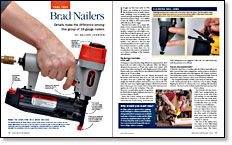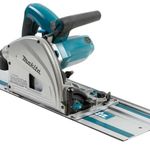Tool Test: Brad Nailers
Details make the difference among this group of 18-gauge nailers
Synopsis: Brad nailers on the market today are better than ever for woodworkers who want to use them to attach moldings to fine furniture and cabinetry. Roland Johnson reviews a dizzying number of nailers and assesses their price, weight, depth-of-set adjuster, driver-guide cover removal, safety-guard location, exhaust-port adjustment, and belt hook — and then shares his comments.
From Fine Woodworking #168
I bought my first brad nailer in 1992 when I was working on an entryway that included scores of small custommade moldings. Tired of dealing with cracked and split moldings that also were marred by hammer dings, I was thrilled to have the ability to drive and set finish nails with the pull of a trigger.
That first brad nailer was a cheap utilitarian version: It jammed fairly often, and it was a bit clumsy to use. After a few months, I stepped up and bought a top-of-the-line tool that has given me years of good service to this day.
When the editors at Fine Woodworking asked me to survey the brad nailers currently on the market, I was pleased to discover that several manufacturers have made a number of improvements to earlier models. These tools are better than ever for woodworkers who want to use brad nailers to fasten moldings to fine furniture and cabinetry.
I’m happy to report that by using 100 psi of compressed air, all of these tools were able to drive 2-in. nails into white oak. When I dropped the pressure to 90 psi, the results were mixed, with some of the nailers leaving the nails slightly proud of the surface. Shorter nails were easily driven to the adjusted depth by all of the nailers at the 90-psi setting.
The three top performers were the Grizzly, the Paslode, and the Porter-Cable because they drove the 2-in. nails all the way no matter how fast I pulled the trigger. Because of its light weight, the Paslode tended to kick back more as I drove the 2-in. nails, the same way a lightweight shotgun will kick back harder than a heavy gun. As a result, I had to keep firm hand pressure against the tool on the workpiece. That said, however, I would rather spend a long day in the field with the lightweight gun because it’s a lot less tiring to handle.
For the full article, download the PDF below.
Fine Woodworking Recommended Products

Milwaukee M12 23-Gauge Cordless Pin Nailer

Makita SP6000J1 Track Saw

Craftsman Random Orbit Sander






















Log in or create an account to post a comment.
Sign up Log in